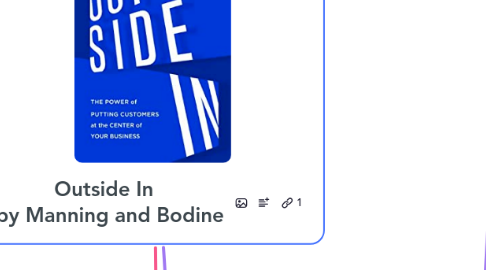
1. I. The Value of Customer Experience
1.1. 1. You need customers more than they need you
1.1.1. You are in the customer business, whether you know it or not
1.1.2. CX is how your customers perceive their interactions with your company
1.1.3. Customer Journey
1.1.4. Customer Experience Pyramid
1.1.5. Age of the Customer
1.1.6. New imperative aligned around customers
1.1.6.1. Employees
1.1.6.2. Partners
1.1.6.3. Processes
1.1.6.4. Policies
1.1.6.5. Technology
1.1.7. Overall goal: deliver a great customer experience.
1.2. 2. Customer Experience Means Billions to Business
1.2.1. CX
1.2.1.1. Powerful differentiator
1.2.1.2. Companies will compete on the basis of CX
1.2.1.3. Leads to profits if you treat it as a business discipline
1.2.2. CX problems
1.2.2.1. Find
1.2.2.2. Fix
1.2.2.3. Measure results
1.2.3. CX correlates to loyalty
1.2.3.1. Purchase intent
1.2.3.2. Churn
1.2.3.3. Word of mouth
1.3. 3. The Customer Experience Ecosystem
1.3.1. Look at the problems from the customer's perspective - from the outside in
1.3.2. Complex set of relationships and connections that determines quality of customer interactions
1.3.2.1. Employees
1.3.2.2. Partners
1.3.2.3. Customers
1.3.3. Players in your CX ecosystem
1.4. 4. From bumper sticker to business discipline
1.4.1. Manage from the perspective of your customers
1.4.1.1. Systematic
1.4.1.2. Repeatable
1.4.1.3. Disciplined
2. II. The Six Disciplines of Customer Experience
2.1. 5. Strategy
2.1.1. Your game plan
2.1.2. Blueprint for customer experience
2.1.2.1. Design
2.1.2.2. Deliver
2.1.2.3. Manage
2.1.2.4. Measure
2.1.3. CX strategy
2.1.3.1. Match corporate strategy
2.1.3.2. Align with your brand
2.1.3.3. Specific, clear, and memorable
2.2. 6. Customer understanding
2.2.1. Customer understanding
2.2.1.1. Who are they?
2.2.1.2. What do they want & need?
2.2.1.3. What are their perceptions of interactions with you?
2.2.1.4. Personas help document who your customers really are
2.2.1.5. Journey maps help document what your customers really do
2.2.2. Thinking vs knowing
2.2.2.1. Thinking you know what they want is risky
2.2.2.2. Knowing what they want leads to CX improvements
2.2.3. Customer feedback
2.2.3.1. Beyond surveys
2.2.3.2. Unsolicited customer feedback
2.2.3.3. Share insights early and often
2.3. 7. Design
2.3.1. Customer interactions that meet or exceed customer needs
2.3.1.1. Envision
2.3.1.2. Human-centered design
2.3.1.3. Implement
2.4. 8. Measurement
2.4.1. Measurement keeps CX on track
2.4.1.1. Cause
2.4.1.2. Effect
2.4.1.3. Business outcome
2.4.2. Quantify CX quality in a consistent manner across the enterprise
2.4.2.1. What to measure
2.4.2.2. How to measure
2.4.2.3. What it means for business
2.4.3. 2 tiers
2.4.3.1. Big picture
2.4.3.1.1. Broad view of CX
2.4.3.1.2. Entire company
2.4.3.1.3. Across time
2.4.3.2. Discrete, end-to-end customer journeys
2.4.4. CX Metrics
2.4.4.1. Descriptive metrics
2.4.4.2. Perception metrics
2.4.4.3. Outcome metrics
2.5. 9. Governance
2.5.1. Organizational set of practices to manage CX
2.5.1.1. Define a consistent set of CX standards
2.5.1.2. Proactive
2.5.1.3. Consistent
2.5.2. Rule book and referees to implement CX strategy
2.5.2.1. Accountability
2.5.2.2. Keep bad experience at bay
2.6. 10. Culture
2.6.1. Build a customer-centric culture
2.6.2. Shared values and behaviors that focus employees on delivering a great CX
2.6.2.1. Hire for customer passion and cultural fit
2.6.2.2. Socialization
2.6.2.3. Rewards
3. III. How Customer Experience Transforms Companies
3.1. 11. The natural path to customer experience maturity
3.1.1. Improve
3.1.1.1. Finding and improving CX problems
3.1.2. Transform
3.1.2.1. Focus on adopting the 6 disciplines of CX
3.1.3. Sustain
3.1.3.1. Retain support for CX efforts regardless of how business conditions change
3.2. 12. The rise of the chief customer officer
3.2.1. CCO is an executive tasked with leading CX efforts across an entire company or division
3.3. 13. Customer experience race is on
3.3.1. CX provides competitive edge
3.3.2. Multichannel orchestration
3.3.3. Tips on CX transformation
3.3.3.1. 1. You need customers more than they need you
3.3.3.2. 2. Examine why your company exists in the first places (company mission)
3.3.3.3. 3. Learn what it feels like to be your customer
3.3.3.4. 4. Talk to your customers
3.3.3.5. 5. Talk to your frontline employees
3.3.3.6. 6. Map a CX ecosystem for one of your company's most important customer journeys
3.3.3.7. 7. Connect dots by building a simple business case for CX improvement project
